Advancements and Applications of Industry Foundation Classes Standards in Engineering: A Comprehensive Review
Abstract
1. Introduction
2. Methodology
3. Literature Analysis
3.1. Research on IFC Applications in Engineering Fields
3.1.1. IFC Applications in the Design Phase
3.1.2. IFC Applications in the Construction Phase
3.1.3. IFC Applications in the Operations and Maintenance Phase
3.2. Interoperability
3.2.1. Information Integration
3.2.2. Information Exchange
3.3. Research on IFC Data Processing
3.3.1. IFC Extension
3.3.2. IFC Data Storage and Representation
3.3.3. IFC Validation
3.3.4. IFC Comparison
3.3.5. IFC Compression
3.3.6. IFC Generation
3.3.7. IFC Merging
4. Discussion
4.1. Development Path of IFC-Related Research
4.2. Limitations and Challenges in IFC Development
4.2.1. Inherent Limitations of IFC Data Format
4.2.2. External Implementation Limitations
4.3. Future Research Directions and Recommendations
5. Conclusions
Author Contributions
Funding
Data Availability Statement
Conflicts of Interest
References
- Sacks, R.; Eastman, C.; Lee, G.; Teicholz, P. BIM Handbook: A Guide to Building Information Modeling for Owners, Designers, Engineers, Contractors, and Facility Managers, 1st ed.; Wiley: Hoboken, NJ, USA, 2018; ISBN 978-1-119-28753-7. [Google Scholar]
- buildingSMART Industry Foundation Classes (IFC). Available online: https://technical.buildingsmart.org/standards/ifc/ (accessed on 7 April 2025).
- ISO 10303-11:2004; Industrial automation systems and integration—Product data representation and exchange—Part 11: Description methods: The EXPRESS language reference manual. International Organization for Standardization: Geneva, Switzerland, 2004.
- Owolabi, A.; Anumba, C.J.; El-Hamalawi, A.; Harper, C. Development of an Industry Foundation Classes Assembly Viewer. J. Comput. Civ. Eng. 2006, 20, 121–131. [Google Scholar] [CrossRef]
- IFC Schema Specifications—Building Smart Technical. Available online: https://technical.buildingsmart.org/standards/ifc/ifc-schema-specifications/ (accessed on 11 August 2025).
- Plume, J.; Mitchell, J. Collaborative Design Using a Shared IFC Building Model—Learning from Experience. Autom. Constr. 2007, 16, 28–36. [Google Scholar] [CrossRef]
- Ding, L.; Li, K.; Zhou, Y.; Love, P.E.D. An IFC-Inspection Process Model for Infrastructure Projects: Enabling Real-Time Quality Monitoring and Control. Autom. Constr. 2017, 84, 96–110. [Google Scholar] [CrossRef]
- Kim, K.; Kim, H.; Kim, W.; Kim, C.; Kim, J.; Yu, J. Integration of Ifc Objects and Facility Management Work Information Using Semantic Web. Autom. Constr. 2018, 87, 173–187. [Google Scholar] [CrossRef]
- Costin, A.; Adibfar, A.; Hu, H.; Chen, S.S. Building Information Modeling (BIM) for Transportation Infrastructure—Literature Review, Applications, Challenges, and Recommendations. Autom. Constr. 2018, 94, 257–281. [Google Scholar] [CrossRef]
- Zhu, J.; Wright, G.; Wang, J.; Wang, X. A Critical Review of the Integration of Geographic Information System and Building Information Modelling at the Data Level. ISPRS Int. J. Geo-Inf. 2018, 7, 66. [Google Scholar] [CrossRef]
- Vilutiene, T.; Kalibatiene, D.; Hosseini, M.R.; Pellicer, E.; Zavadskas, E.K. Building Information Modeling (BIM) for Structural Engineering: A Bibliometric Analysis of the Literature. Adv. Civ. Eng. 2019, 2019, 5290690. [Google Scholar] [CrossRef]
- Liu, L.; Li, B.; Zlatanova, S.; Van Oosterom, P. Indoor Navigation Supported by the Industry Foundation Classes (IFC): A Survey. Autom. Constr. 2021, 121, 103436. [Google Scholar] [CrossRef]
- Yu, Y.; Kim, S.; Jeon, H.; Koo, B. A Systematic Review of the Trends and Advances in IFC Schema Extensions for BIM Interoperability. Appl. Sci. 2023, 13, 12560. [Google Scholar] [CrossRef]
- Jia, J.; Ma, H.; Zhang, Z. Integration of Industry Foundation Classes and Ontology: Data, Applications, Modes, Challenges, and Opportunities. Buildings 2024, 14, 911. [Google Scholar] [CrossRef]
- Zhang, J.; El-Gohary, N.M. Extending Building Information Models Semiautomatically Using Semantic Natural Language Processing Techniques. J. Comput. Civ. Eng. 2016, 30, C4016004. [Google Scholar] [CrossRef]
- Yang, Q.Z.; Xu, X. Design Knowledge Modeling and Software Implementation for Building Code Compliance Checking. Build. Environ. 2004, 39, 689–698. [Google Scholar] [CrossRef]
- Zhang, R.; El-Gohary, N. Transformer-Based Approach for Automated Context-Aware IFC-Regulation Semantic Information Alignment. Autom. Constr. 2023, 145, 104540. [Google Scholar] [CrossRef]
- Patlakas, P.; Christovasilis, I.; Riparbelli, L.; Cheung, F.K.; Vakaj, E. Semantic Web-Based Automated Compliance Checking with Integration of Finite Element Analysis. Adv. Eng. Inform. 2024, 61, 102448. [Google Scholar] [CrossRef]
- Pauwels, P.; Van Deursen, D.; Verstraeten, R.; De Roo, J.; De Meyer, R.; Van De Walle, R.; Van Campenhout, J. A Semantic Rule Checking Environment for Building Performance Checking. Autom. Constr. 2011, 20, 506–518. [Google Scholar] [CrossRef]
- Kamel, E.; Memari, A.M. Review of BIM’s Application in Energy Simulation: Tools, Issues, and Solutions. Autom. Constr. 2019, 97, 164–180. [Google Scholar] [CrossRef]
- Kim, H.; Shen, Z.; Kim, I.; Kim, K.; Stumpf, A.; Yu, J. BIM IFC Information Mapping to Building Energy Analysis (BEA) Model with Manually Extended Material Information. Autom. Constr. 2016, 68, 183–193. [Google Scholar] [CrossRef]
- Lilis, G.N.; Giannakis, G.I.; Rovas, D.V. Automatic Generation of Second-Level Space Boundary Topology from IFC Geometry Inputs. Autom. Constr. 2017, 76, 108–124. [Google Scholar] [CrossRef]
- Ramaji, I.J.; Messner, J.I.; Mostavi, E. IFC-Based BIM-to-BEM Model Transformation. J. Comput. Civ. Eng. 2020, 34, 04020005. [Google Scholar] [CrossRef]
- Li, H.; Zhang, J. Improving IFC-Based Interoperability between BIM and BEM Using Invariant Signatures of HVAC Objects. J. Comput. Civ. Eng. 2023, 37, 04022059. [Google Scholar] [CrossRef]
- Choi, J.; Lee, S. A Suggestion of the Alternatives Evaluation Method through IFC-Based Building Energy Performance Analysis. Sustainability 2023, 15, 1797. [Google Scholar] [CrossRef]
- Chen, Z.; Chen, L.; Zhou, X.; Huang, L.; Sandanayake, M.; Yap, P.-S. Recent Technological Advancements in BIM and LCA Integration for Sustainable Construction: A Review. Sustainability 2024, 16, 1340. [Google Scholar] [CrossRef]
- Zimmermann, R.K.; Bruhn, S.; Birgisdóttir, H. BIM-Based Life Cycle Assessment of Buildings—An Investigation of Industry Practice and Needs. Sustainability 2021, 13, 5455. [Google Scholar] [CrossRef]
- Santos, R.; Costa, A.A.; Silvestre, J.D.; Pyl, L. Integration of LCA and LCC Analysis within a BIM-Based Environment. Autom. Constr. 2019, 103, 127–149. [Google Scholar] [CrossRef]
- LLatas, C.; Soust-Verdaguer, B.; Hollberg, A.; Palumbo, E.; Quiñones, R. BIM-Based LCSA Application in Early Design Stages Using IFC. Autom. Constr. 2022, 138, 104259. [Google Scholar] [CrossRef]
- Oh, M.; Lee, J.; Hong, S.W.; Jeong, Y. Integrated System for BIM-Based Collaborative Design. Autom. Constr. 2015, 58, 196–206. [Google Scholar] [CrossRef]
- Khudhair, A.; Li, H.; Bower, T.; Ren, G. A Theoretical Holistic Decision-Making Framework Supporting Collaborative Design Based on Common Data Analysis (CDA) Method. J. Build. Eng. 2022, 46, 103686. [Google Scholar] [CrossRef]
- El-Diraby, T.; Krijnen, T.; Papagelis, M. BIM-Based Collaborative Design and Socio-Technical Analytics of Green Buildings. Autom. Constr. 2017, 82, 59–74. [Google Scholar] [CrossRef]
- Lee, S.-H.; Park, S.I.; Park, J. Development of an IFC-Based Data Schema for the Design Information Representation of the NATM Tunnel. KSCE J. Civ. Eng. 2016, 20, 2112–2123. [Google Scholar] [CrossRef]
- Park, S.I.; Park, J.; Kim, B.-G.; Lee, S.-H. Improving Applicability for Information Model of an IFC-Based Steel Bridge in the Design Phase Using Functional Meanings of Bridge Components. Appl. Sci. 2018, 8, 2531. [Google Scholar] [CrossRef]
- Châteauvieux-Hellwig, C.; Abualdenien, J.; Borrmann, A. Analysis of Early-Design Timber Models for Sound Insulation. Adv. Eng. Inform. 2022, 53, 101675. [Google Scholar] [CrossRef]
- Yang, B.; Liu, B.; Xiao, J.; Zhang, B.; Wang, Z.; Dong, M. A Novel Construction Scheduling Framework for a Mixed Construction Process of Precast Components and Cast-in-Place Parts in Prefabricated Buildings. J. Build. Eng. 2021, 43, 103181. [Google Scholar] [CrossRef]
- Al-Sinan, M.A.; Bubshait, A.A.; Aljaroudi, Z. Generation of Construction Scheduling through Machine Learning and BIM: A Blueprint. Buildings 2024, 14, 934. [Google Scholar] [CrossRef]
- Golparvar-Fard, M.; Peña-Mora, F.; Savarese, S. Automated Progress Monitoring Using Unordered Daily Construction Photographs and IFC-Based Building Information Models. J. Comput. Civ. Eng. 2015, 29, 04014025. [Google Scholar] [CrossRef]
- Kavaliauskas, P.; Fernandez, J.B.; McGuinness, K.; Jurelionis, A. Automation of Construction Progress Monitoring by Integrating 3D Point Cloud Data with an IFC-Based BIM Model. Buildings 2022, 12, 1754. [Google Scholar] [CrossRef]
- Yang, B.; Dong, M.; Wang, C.; Liu, B.; Wang, Z.; Zhang, B. IFC-Based 4D Construction Management Information Model of Prefabricated Buildings and Its Application in Graph Database. Appl. Sci. 2021, 11, 7270. [Google Scholar] [CrossRef]
- Hamledari, H.; McCabe, B.; Davari, S.; Shahi, A. Automated Schedule and Progress Updating of IFC-Based 4D BIMs. J. Comput. Civ. Eng. 2017, 31, 04017012. [Google Scholar] [CrossRef]
- Providakis, S.; Rogers, C.D.F.; Chapman, D.N. Predictions of Settlement Risk Induced by Tunnelling Using BIM and 3D Visualization Tools. Tunn. Undergr. Space Technol. 2019, 92, 103049. [Google Scholar] [CrossRef]
- Zhang, Y.; Xing, X.; Antwi-Afari, M.F. Semantic IFC Data Model for Automatic Safety Risk Identification in Deep Excavation Projects. Appl. Sci. 2021, 11, 9958. [Google Scholar] [CrossRef]
- Xun, X.; Zhang, J.; Yuan, Y. Multi-Information Fusion Based on BIM and Intuitionistic Fuzzy D-S Evidence Theory for Safety Risk Assessment of Undersea Tunnel Construction Projects. Buildings 2022, 12, 1802. [Google Scholar] [CrossRef]
- Guo, B.H.W.; Goh, Y.M. Ontology for Design of Active Fall Protection Systems. Autom. Constr. 2017, 82, 138–153. [Google Scholar] [CrossRef]
- Mirshokraei, M.; De Gaetani, C.I.; Migliaccio, F. A Web-Based BIM–AR Quality Management System for Structural Elements. Appl. Sci. 2019, 9, 3984. [Google Scholar] [CrossRef]
- Schwabe, K.; Teizer, J.; König, M. Applying Rule-Based Model-Checking to Construction Site Layout Planning Tasks. Autom. Constr. 2019, 97, 205–219. [Google Scholar] [CrossRef]
- Hamledari, H.; Rezazadeh Azar, E.; McCabe, B. IFC-Based Development of As-Built and As-Is BIMs Using Construction and Facility Inspection Data: Site-to-BIM Data Transfer Automation. J. Comput. Civ. Eng. 2018, 32, 04017075. [Google Scholar] [CrossRef]
- Bariczová, G.; Erdélyi, J.; Honti, R.; Tomek, L. Wall Structure Geometry Verification Using TLS Data and BIM Model. Appl. Sci. 2021, 11, 11804. [Google Scholar] [CrossRef]
- Zhang, J.; Yu, F.; Li, D.; Hu, Z. Development and Implementation of an Industry Foundation Classes-Based Graphic Information Model for Virtual Construction. Comput.-Aided Civ. Infrastruct. Eng. 2014, 29, 60–74. [Google Scholar] [CrossRef]
- Huymajer, M.; Melnyk, O.; Wenighofer, R.; Huemer, C.; Galler, R. Building Information Modeling in the Execution Phase of Conventional Tunneling Projects. Tunn. Undergr. Space Technol. 2024, 146, 105539. [Google Scholar] [CrossRef]
- Chen, W.; Chen, K.; Cheng, J.C.P.; Wang, Q.; Gan, V.J.L. BIM-Based Framework for Automatic Scheduling of Facility Maintenance Work Orders. Autom. Constr. 2018, 91, 15–30. [Google Scholar] [CrossRef]
- Marmo, R.; Polverino, F.; Nicolella, M.; Tibaut, A. Building Performance and Maintenance Information Model Based on IFC Schema. Autom. Constr. 2020, 118, 103275. [Google Scholar] [CrossRef]
- Fitz, T.; Theiler, M.; Smarsly, K. A Metamodel for Cyber-Physical Systems. Adv. Eng. Inform. 2019, 41, 100930. [Google Scholar] [CrossRef]
- Kwon, T.H.; Park, S.H.; Park, S.I.; Lee, S.-H. Building Information Modeling-Based Bridge Health Monitoring for Anomaly Detection under Complex Loading Conditions Using Artificial Neural Networks. J. Civ. Struct. Health Monit. 2021, 11, 1301–1319. [Google Scholar] [CrossRef]
- Xu, S.; Wang, J.; Wang, X.; Wu, P.; Shou, W.; Liu, C. A Parameter-Driven Method for Modeling Bridge Defects through IFC. J. Comput. Civ. Eng. 2022, 36, 04022015. [Google Scholar] [CrossRef]
- Hüthwohl, P.; Brilakis, I.; Borrmann, A.; Sacks, R. Integrating RC Bridge Defect Information into BIM Models. J. Comput. Civ. Eng. 2018, 32, 04018013. [Google Scholar] [CrossRef]
- Artus, M.; Alabassy, M.S.H.; Koch, C. A BIM Based Framework for Damage Segmentation, Modeling, and Visualization Using IFC. Appl. Sci. 2022, 12, 2772. [Google Scholar] [CrossRef]
- Hu, M.; Liu, Y.; Sugumaran, V.; Liu, B.; Du, J. Automated Structural Defects Diagnosis in Underground Transportation Tunnels Using Semantic Technologies. Autom. Constr. 2019, 107, 102929. [Google Scholar] [CrossRef]
- Sanz-Jimeno, R.; Álvarez-Díaz, S. A Tool Based on the Industry Foundation Classes Standard for Dynamic Data Collection and Automatic Generation of Building Automation Control Networks. J. Build. Eng. 2023, 78, 107625. [Google Scholar] [CrossRef]
- Lu, Q.; Xie, X.; Parlikad, A.K.; Schooling, J.M. Digital Twin-Enabled Anomaly Detection for Built Asset Monitoring in Operation and Maintenance. Autom. Constr. 2020, 118, 103277. [Google Scholar] [CrossRef]
- Hamieh, A.; Ben Makhlouf, A.; Louhichi, B.; Deneux, D. A BIM-Based Method to Plan Indoor Paths. Autom. Constr. 2020, 113, 103120. [Google Scholar] [CrossRef]
- Mirahadi, F.; McCabe, B.Y. EvacuSafe: A Real-Time Model for Building Evacuation Based on Dijkstra’s Algorithm. J. Build. Eng. 2021, 34, 101687. [Google Scholar] [CrossRef]
- Taneja, S.; Akinci, B.; Garrett, J.H.; Soibelman, L. Algorithms for Automated Generation of Navigation Models from Building Information Models to Support Indoor Map-Matching. Autom. Constr. 2016, 61, 24–41. [Google Scholar] [CrossRef]
- Lin, W.Y.; Lin, P.H. Intelligent Generation of Indoor Topology (i-GIT) for Human Indoor Pathfinding Based on IFC Models and 3D GIS Technology. Autom. Constr. 2018, 94, 340–359. [Google Scholar] [CrossRef]
- Boje, C.; Li, H. Crowd Simulation-Based Knowledge Mining Supporting Building Evacuation Design. Adv. Eng. Inform. 2018, 37, 103–118. [Google Scholar] [CrossRef]
- Lai, H.; Deng, X. Interoperability Analysis of Ifc-Based Data Exchange Between Heterogeneous Bim Software. J. Civ. Eng. Manag. 2018, 24, 537–555. [Google Scholar] [CrossRef]
- Gerbino, S.; Cieri, L.; Rainieri, C.; Fabbrocino, G. On BIM Interoperability via the IFC Standard: An Assessment from the Structural Engineering and Design Viewpoint. Appl. Sci. 2021, 11, 11430. [Google Scholar] [CrossRef]
- Shoieb, K.; Serror, M.H.; Marzouk, M. Web-Based Tool for Interoperability among Structural Analysis Applications. J. Constr. Eng. Manag. 2020, 146, 04020058. [Google Scholar] [CrossRef]
- Sibenik, G.; Kovacic, I. Assessment of Model-Based Data Exchange between Architectural Design and Structural Analysis. J. Build. Eng. 2020, 32, 101589. [Google Scholar] [CrossRef]
- De Gaetani, C.I.; Mert, M.; Migliaccio, F. Interoperability Analyses of BIM Platforms for Construction Management. Appl. Sci. 2020, 10, 4437. [Google Scholar] [CrossRef]
- Zheng, B.; Hussain, M.; Yang, Y.; Chan, A.P.C.; Chi, H.-L. Trade-Offs between Accuracy and Efficiency in BIM-LCA Integration. Eng. Constr. Archit. Manag. 2025, 32, 237–258. [Google Scholar] [CrossRef]
- Borrmann, A.; Kolbe, T.H.; Donaubauer, A.; Steuer, H.; Jubierre, J.R.; Flurl, M. Multi-Scale Geometric-Semantic Modeling of Shield Tunnels for GIS and BIM Applications. Comput.-Aided Civ. Infrastruct. Eng. 2015, 30, 263–281. [Google Scholar] [CrossRef]
- Harshit; Chaurasia, P.; Zlatanova, S.; Jain, K. Low-Cost Data, High-Quality Models: A Semi-Automated Approach to LOD3 Creation. ISPRS Int. J. Geo-Inf. 2024, 13, 119. [Google Scholar] [CrossRef]
- Zhu, J.; Wu, P. BIM/GIS Data Integration from the Perspective of Information Flow. Autom. Constr. 2022, 136, 104166. [Google Scholar] [CrossRef]
- Lam, P.-D.; Gu, B.-H.; Lam, H.-K.; Ok, S.-Y.; Lee, S.-H. Digital Twin Smart City: Integrating IFC and CityGML with Semantic Graph for Advanced 3D City Model Visualization. Sensors 2024, 24, 3761. [Google Scholar] [CrossRef]
- Tan, Y.; Liang, Y.; Zhu, J. CityGML in the Integration of BIM and the GIS: Challenges and Opportunities. Buildings 2023, 13, 1758. [Google Scholar] [CrossRef]
- Liu, Y.; Lin, H.; Zhao, Z.; Bai, W.; Hu, N. Research on the Visualization of Railway Signal Operation and Maintenance Based on BIM + GIS. Sensors 2023, 23, 5984. [Google Scholar] [CrossRef]
- Čuš-Babič, N.; Guerra De Oliveira, S.F.; Tibaut, A. Interoperability of Infrastructure and Transportation Information Models: A Public Transport Case Study. Appl. Sci. 2022, 12, 6234. [Google Scholar] [CrossRef]
- Chen, J.; Lu, W.; Pan, Y.; Fu, Y. Building “RoboAvatar”: Industry Foundation Classes–Based Digital Representation of Robots in the Built Environment. J. Comput. Civ. Eng. 2024, 38, 04024013. [Google Scholar] [CrossRef]
- Ma, G.; Jiang, J.; Shang, S. Visualization of Component Status Information of Prefabricated Concrete Building Based on Building Information Modeling and Radio Frequency Identification: A Case Study in China. Adv. Civ. Eng. 2019, 2019, 6870507. [Google Scholar] [CrossRef]
- Wang, M.; Deng, Y.; Won, J.; Cheng, J.C.P. An Integrated Underground Utility Management and Decision Support Based on BIM and GIS. Autom. Constr. 2019, 107, 102931. [Google Scholar] [CrossRef]
- Shi, J.; Pan, Z.; Jiang, L.; Zhai, X. An Ontology-Based Methodology to Establish City Information Model of Digital Twin City by Merging BIM, GIS and IoT. Adv. Eng. Inform. 2023, 57, 102114. [Google Scholar] [CrossRef]
- Gradišar, L.; Dolenc, M. IFC and Monitoring Database System Based on Graph Data Models. Adv. Civ. Eng. 2021, 2021, 4913394. [Google Scholar] [CrossRef]
- Wyszomirski, M.; Gotlib, D. A Unified Database Solution to Process BIM and GIS Data. Appl. Sci. 2020, 10, 8518. [Google Scholar] [CrossRef]
- Pinheiro, S.; Wimmer, R.; O’Donnell, J.; Muhic, S.; Bazjanac, V.; Maile, T.; Frisch, J.; Van Treeck, C. MVD Based Information Exchange between BIM and Building Energy Performance Simulation. Autom. Constr. 2018, 90, 91–103. [Google Scholar] [CrossRef]
- Tang, S.; Shelden, D.R.; Eastman, C.M.; Pishdad-Bozorgi, P.; Gao, X. BIM Assisted Building Automation System Information Exchange Using BACnet and IFC. Autom. Constr. 2020, 110, 103049. [Google Scholar] [CrossRef]
- Liu, Y.; Li, M.; Wong, B.C.L.; Chan, C.M.; Cheng, J.C.P.; Gan, V.J.L. BIM-BVBS Integration with openBIM Standards for Automatic Prefabrication of Steel Reinforcement. Autom. Constr. 2021, 125, 103654. [Google Scholar] [CrossRef]
- Ciccone, A.; Ciotta, V.; Asprone, D. Integration of structural information within a BIM-based environment for seismic structural e-permits. J. Civ. Eng. Manag. 2023, 29, 171–193. [Google Scholar] [CrossRef]
- Lee, Y.-C.; Shariatfar, M.; Ghannad, P.; Zhang, J.; Lee, J.-K. Generation of Entity-Based Integrated Model View Definition Modules for the Development of New BIM Data Exchange Standards. J. Comput. Civ. Eng. 2020, 34, 04020011. [Google Scholar] [CrossRef]
- Lee, G.; Park, Y.H.; Ham, S. Extended Process to Product Modeling (xPPM) for Integrated and Seamless IDM and MVD Development. Adv. Eng. Inform. 2013, 27, 636–651. [Google Scholar] [CrossRef]
- Lee, Y.-C.; Eastman, C.M.; Solihin, W. An Ontology-Based Approach for Developing Data Exchange Requirements and Model Views of Building Information Modeling. Adv. Eng. Inform. 2016, 30, 354–367. [Google Scholar] [CrossRef]
- Farias, T.M.D.; Roxin, A.; Nicolle, C. A Rule-Based Methodology to Extract Building Model Views. Autom. Constr. 2018, 92, 214–229. [Google Scholar] [CrossRef]
- Won, J.; Lee, G.; Cho, C. No-Schema Algorithm for Extracting a Partial Model from an IFC Instance Model. J. Comput. Civ. Eng. 2013, 27, 585–592. [Google Scholar] [CrossRef]
- Gui, N.; Wang, C.; Qiu, Z.; Gui, W.; Deconinck, G. IFC-Based Partial Data Model Retrieval for Distributed Collaborative Design. J. Comput. Civ. Eng. 2019, 33, 04019016. [Google Scholar] [CrossRef]
- Lai, H.; Zhou, C.; Deng, X. Exchange Requirement-Based Delivery Method of Structural Design Information for Collaborative Design Using Industry Foundation Classes. J. Civ. Eng. Manag. 2019, 25, 559–573. [Google Scholar] [CrossRef]
- Deng, X.; Lai, H.; Xu, J.; Zhao, Y. Generic Language for Partial Model Extraction from an IFC Model Based on Selection Set. Appl. Sci. 2020, 10, 1968. [Google Scholar] [CrossRef]
- Zheng, Y.; Shi, Y.; Wang, X. Research on Partial Model Extraction of Railway Infrastructure Based on the Industry Foundation Classes Files. IEEE Access 2024, 12, 94690–94701. [Google Scholar] [CrossRef]
- Kim, I.; Kim, J.; Seo, J. Development of an IFC-Based IDF Converter for Supporting Energy Performance Assessment in the Early Design Phase. J. Asian Archit. Build. Eng. 2012, 11, 313–320. [Google Scholar] [CrossRef]
- Deng, Y.; Cheng, J.C.P.; Anumba, C. Mapping between BIM and 3D GIS in Different Levels of Detail Using Schema Mediation and Instance Comparison. Autom. Constr. 2016, 67, 1–21. [Google Scholar] [CrossRef]
- Stouffs, R.; Tauscher, H.; Biljecki, F. Achieving Complete and Near-Lossless Conversion from IFC to CityGML. ISPRS Int. J. Geo-Inf. 2018, 7, 355. [Google Scholar] [CrossRef]
- Jetlund, K.; Onstein, E.; Huang, L. IFC Schemas in ISO/TC 211 Compliant UML for Improved Interoperability between BIM and GIS. ISPRS Int. J. Geo-Inf. 2020, 9, 278. [Google Scholar] [CrossRef]
- Chen, Y.; Shooraj, E.; Rajabifard, A.; Sabri, S. From IFC to 3D Tiles: An Integrated Open-Source Solution for Visualising BIMs on Cesium. ISPRS Int. J. Geo-Inf. 2018, 7, 393. [Google Scholar] [CrossRef]
- Zhu, J.; Wang, X.; Wang, P.; Wu, Z.; Kim, M.J. Integration of BIM and GIS: Geometry from IFC to Shapefile Using Open-Source Technology. Autom. Constr. 2019, 102, 105–119. [Google Scholar] [CrossRef]
- Zhu, J.; Wang, X.; Chen, M.; Wu, P.; Kim, M.J. Integration of BIM and GIS: IFC Geometry Transformation to Shapefile Using Enhanced Open-Source Approach. Autom. Constr. 2019, 106, 102859. [Google Scholar] [CrossRef]
- Zhu, J.; Wu, P.; Chen, M.; Kim, M.J.; Wang, X.; Fang, T. Automatically Processing IFC Clipping Representation for BIM and GIS Integration at the Process Level. Appl. Sci. 2020, 10, 2009. [Google Scholar] [CrossRef]
- Zhu, J.; Wu, P. Towards Effective BIM/GIS Data Integration for Smart City by Integrating Computer Graphics Technique. Remote Sens. 2021, 13, 1889. [Google Scholar] [CrossRef]
- Zhu, A.; Pauwels, P.; De Vries, B. Component-Based Robot Prefabricated Construction Simulation Using IFC-Based Building Information Models. Autom. Constr. 2023, 152, 104899. [Google Scholar] [CrossRef]
- Kim, K.; Peavy, M. BIM-Based Semantic Building World Modeling for Robot Task Planning and Execution in Built Environments. Autom. Constr. 2022, 138, 104247. [Google Scholar] [CrossRef]
- Zhang, S.; Hou, D.; Wang, C.; Pan, F.; Yan, L. Integrating and Managing BIM in 3D Web-Based GIS for Hydraulic and Hydropower Engineering Projects. Autom. Constr. 2020, 112, 103114. [Google Scholar] [CrossRef]
- Koo, B.; La, S.; Cho, N.-W.; Yu, Y. Using Support Vector Machines to Classify Building Elements for Checking the Semantic Integrity of Building Information Models. Autom. Constr. 2019, 98, 183–194. [Google Scholar] [CrossRef]
- Xu, Z.; Xie, Z.; Wang, X.; Niu, M. Automatic Classification and Coding of Prefabricated Components Using IFC and the Random Forest Algorithm. Buildings 2022, 12, 688. [Google Scholar] [CrossRef]
- Xiao, M.; Chao, Z.; Coelho, R.F.; Tian, S. Investigation of Classification and Anomalies Based on Machine Learning Methods Applied to Large Scale Building Information Modeling. Appl. Sci. 2022, 12, 6382. [Google Scholar] [CrossRef]
- Koo, B.; Jung, R.; Yu, Y. Automatic Classification of Wall and Door BIM Element Subtypes Using 3D Geometric Deep Neural Networks. Adv. Eng. Inform. 2021, 47, 101200. [Google Scholar] [CrossRef]
- Emunds, C.; Pauen, N.; Richter, V.; Frisch, J.; Van Treeck, C. SpaRSE-BIM: Classification of IFC-Based Geometry via Sparse Convolutional Neural Networks. Adv. Eng. Inform. 2022, 53, 101641. [Google Scholar] [CrossRef]
- Kim, I.; Seo, J. Development of IFC Modeling Extension for Supporting Drawing Information Exchange in the Model-Based Construction Environment. J. Comput. Civ. Eng. 2008, 22, 159–169. [Google Scholar] [CrossRef]
- Theiler, M.; Smarsly, K. IFC Monitor—An IFC Schema Extension for Modeling Structural Health Monitoring Systems. Adv. Eng. Inform. 2018, 37, 54–65. [Google Scholar] [CrossRef]
- Petronijević, M.; Višnjevac, N.; Praščević, N.; Bajat, B. The Extension of IFC For Supporting 3D Cadastre LADM Geometry. ISPRS Int. J. Geo-Inf. 2021, 10, 297. [Google Scholar] [CrossRef]
- Building Smart Standards Library. Available online: https://www.buildingsmart.org/standards/bsi-standards/standards-library/ (accessed on 10 April 2025).
- Xu, Z.; Kang, R.; Lu, R. 3D Reconstruction and Measurement of Surface Defects in Prefabricated Elements Using Point Clouds. J. Comput. Civ. Eng. 2020, 34, 04020033. [Google Scholar] [CrossRef]
- Zhiliang, M.; Zhenhua, W.; Wu, S.; Zhe, L. Application and Extension of the IFC Standard in Construction Cost Estimating for Tendering in China. Autom. Constr. 2011, 20, 196–204. [Google Scholar] [CrossRef]
- You, S.-J.; Yang, D.; Eastman, C.M. Relational DB Implementation of STEP Based Product Model. In Proceedings of the CIB World Building Congress 2004, Toronto, ON, USA, 2–7 May 2024; Citeseer: Princeton, NJ, USA, 2004; pp. 2–7. [Google Scholar]
- Solihin, W.; Eastman, C.; Lee, Y.-C.; Yang, D.-H. A Simplified Relational Database Schema for Transformation of BIM Data into a Query-Efficient and Spatially Enabled Database. Autom. Constr. 2017, 84, 367–383. [Google Scholar] [CrossRef]
- Lee, G.; Jeong, J.; Won, J.; Cho, C.; You, S.; Ham, S.; Kang, H. Query Performance of the IFC Model Server Using an Object-Relational Database Approach and a Traditional Relational Database Approach. J. Comput. Civ. Eng. 2014, 28, 210–222. [Google Scholar] [CrossRef]
- Cho, C.Y.; Won, J.; Ham, S. IFC Model Restructuring Framework for Efficient Bulk-Loading to Object-Relational IFC Model Server. KSCE J. Civ. Eng. 2018, 22, 4930–4939. [Google Scholar] [CrossRef]
- Xu, Z.; Huang, T.; Li, B.; Li, H.; Li, Q. Developing an IFC-Based Database for Construction Quality Evaluation. Adv. Civ. Eng. 2018, 2018, 3946051. [Google Scholar] [CrossRef]
- Zhou, Y. Image-Based Onsite Object Recognition for Automatic Crane Lifting Tasks. Autom. Constr. 2021, 123, 103527. [Google Scholar] [CrossRef]
- Esser, S.; Vilgertshofer, S.; Borrmann, A. Graph-Based Version Control for Asynchronous BIM Collaboration. Adv. Eng. Inform. 2022, 53, 101664. [Google Scholar] [CrossRef]
- Zhu, J.; Wu, P.; Lei, X. IFC-Graph for Facilitating Building Information Access and Query. Autom. Constr. 2023, 148, 104778. [Google Scholar] [CrossRef]
- Pauwels, P.; Terkaj, W. EXPRESS to OWL for Construction Industry: Towards a Recommendable and Usable ifcOWL Ontology. Autom. Constr. 2016, 63, 100–133. [Google Scholar] [CrossRef]
- Terkaj, W.; Šojić, A. Ontology-Based Representation of IFC EXPRESS Rules: An Enhancement of the ifcOWL Ontology. Autom. Constr. 2015, 57, 188–201. [Google Scholar] [CrossRef]
- Pauwels, P.; Krijnen, T.; Terkaj, W.; Beetz, J. Enhancing the ifcOWL Ontology with an Alternative Representation for Geometric Data. Autom. Constr. 2017, 80, 77–94. [Google Scholar] [CrossRef]
- Wang, C.; Zhang, L.; Yan, W. Enhancement and Validation of ifcOWL Ontology Based on Shapes Constraint Language (SHACL). Autom. Constr. 2024, 160, 105293. [Google Scholar] [CrossRef]
- Daniotti, B.; Bolognesi, C.M.; Lupica Spagnolo, S.; Pavan, A.; Signorini, M.; Ciuffreda, S.; Mirarchi, C.; Lucky, M.N.; Andersson, B.; Andersson, P.; et al. An Interoperable BIM-Based Toolkit for Efficient Renovation in Buildings. Buildings 2021, 11, 271. [Google Scholar] [CrossRef]
- Yin, M.; Tang, L.; Webster, C.; Xu, S.; Li, X.; Ying, H. An Ontology-Aided, Natural Language-Based Approach for Multi-Constraint BIM Model Querying. J. Build. Eng. 2023, 76, 107066. [Google Scholar] [CrossRef]
- Zhu, J.; Chong, H.-Y.; Zhao, H.; Wu, J.; Tan, Y.; Xu, H. The Application of Graph in BIM/GIS Integration. Buildings 2022, 12, 2162. [Google Scholar] [CrossRef]
- Lin, J.; Hu, Z.; Zhang, J.; Yu, F. A Natural-Language-Based Approach to Intelligent Data Retrieval and Representation for Cloud BIM. Comput.-Aided Civ. Infrastruct. Eng. 2016, 31, 18–33. [Google Scholar] [CrossRef]
- Krijnen, T.; Beetz, J. An Efficient Binary Storage Format for IFC Building Models Using HDF5 Hierarchical Data Format. Autom. Constr. 2020, 113, 103134. [Google Scholar] [CrossRef]
- Lee, Y.-C.; Eastman, C.M.; Lee, J.-K. Validations for Ensuring the Interoperability of Data Exchange of a Building Information Model. Autom. Constr. 2015, 58, 176–195. [Google Scholar] [CrossRef]
- Solihin, W.; Eastman, C.; Lee, Y.-C. Toward Robust and Quantifiable Automated IFC Quality Validation. Adv. Eng. Inform. 2015, 29, 739–756. [Google Scholar] [CrossRef]
- Lee, Y.-C.; Eastman, C.M.; Solihin, W.; See, R. Modularized Rule-Based Validation of a BIM Model Pertaining to Model Views. Autom. Constr. 2016, 63, 1–11. [Google Scholar] [CrossRef]
- Liu, H.; Gao, G.; Zhang, H.; Liu, Y.-S.; Song, Y.; Gu, M. MVDLite: A Fast Validation Algorithm for Model View Definition Rules. Adv. Eng. Inform. 2023, 58, 102132. [Google Scholar] [CrossRef]
- Lee, Y.-C.; Solihin, W.; Eastman, C.M. The Mechanism and Challenges of Validating a Building Information Model Regarding Data Exchange Standards. Autom. Constr. 2019, 100, 118–128. [Google Scholar] [CrossRef]
- Ying, H.; Lee, S. Automatic Detection of Geometric Errors in Space Boundaries of IFC-BIM Models Using Monte Carlo Ray Tracing Approach. J. Comput. Civ. Eng. 2020, 34, 04019056. [Google Scholar] [CrossRef]
- Lee, G.; Won, J.; Ham, S.; Shin, Y. Metrics for Quantifying the Similarities and Differences between IFC Files. J. Comput. Civ. Eng. 2011, 25, 172–181. [Google Scholar] [CrossRef]
- Oraskari, J.; Törmä, S. RDF-Based Signature Algorithms for Computing Differences of IFC Models. Autom. Constr. 2015, 57, 213–221. [Google Scholar] [CrossRef]
- Shi, X.; Liu, Y.-S.; Gao, G.; Gu, M.; Li, H. IFCdiff: A Content-Based Automatic Comparison Approach for IFC Files. Autom. Constr. 2018, 86, 53–68. [Google Scholar] [CrossRef]
- Du, X.; Duan, Y. Submodel Comparison Method Based on IFC File Content. J. Comput. Civ. Eng. 2022, 36, 04022014. [Google Scholar] [CrossRef]
- Sun, J.; Liu, Y.-S.; Gao, G.; Han, X.-G. IFCCompressor: A Content-Based Compression Algorithm for Optimizing Industry Foundation Classes Files. Autom. Constr. 2015, 50, 1–15. [Google Scholar] [CrossRef]
- Du, X.; Gu, Y.; Yang, N.; Yang, F. IFC File Content Compression Based on Reference Relationships. J. Comput. Civ. Eng. 2020, 34, 04020012. [Google Scholar] [CrossRef]
- Xu, H.; Kim, J.I.; Chen, J. An Iterative Reference Mapping Approach for BIM IFCXML Classified Content Compression. Adv. Eng. Inform. 2022, 54, 101788. [Google Scholar] [CrossRef]
- Soilán, M.; Justo, A.; Sánchez-Rodríguez, A.; Riveiro, B. 3D Point Cloud to BIM: Semi-Automated Framework to Define IFC Alignment Entities from MLS-Acquired LiDAR Data of Highway Roads. Remote Sens. 2020, 12, 2301. [Google Scholar] [CrossRef]
- Justo, A.; Lamas, D.; Sánchez-Rodríguez, A.; Soilán, M.; Riveiro, B. Generating IFC-Compliant Models and Structural Graphs of Truss Bridges from Dense Point Clouds. Autom. Constr. 2023, 149, 104786. [Google Scholar] [CrossRef]
- Ariyachandra, M.R.M.F.; Brilakis, I. Leveraging Railway Topology to Automatically Generate Track Geometric Information Models from Airborne LiDAR Data. Autom. Constr. 2023, 155, 105068. [Google Scholar] [CrossRef]
- Urbieta, M.; Urbieta, M.; Laborde, T.; Villarreal, G.; Rossi, G. Generating BIM Model from Structural and Architectural Plans Using Artificial Intelligence. J. Build. Eng. 2023, 78, 107672. [Google Scholar] [CrossRef]
- Pan, Z.; Yu, Y.; Xiao, F.; Zhang, J. Recovering Building Information Model from 2D Drawings for Mechanical, Electrical and Plumbing Systems of Ageing Buildings. Autom. Constr. 2023, 152, 104914. [Google Scholar] [CrossRef]
- Zhao, Q.; Li, Y.; Hei, X.; Yang, M. A Graph-Based Method for IFC Data Merging. Adv. Civ. Eng. 2020, 2020, 8782740. [Google Scholar] [CrossRef]
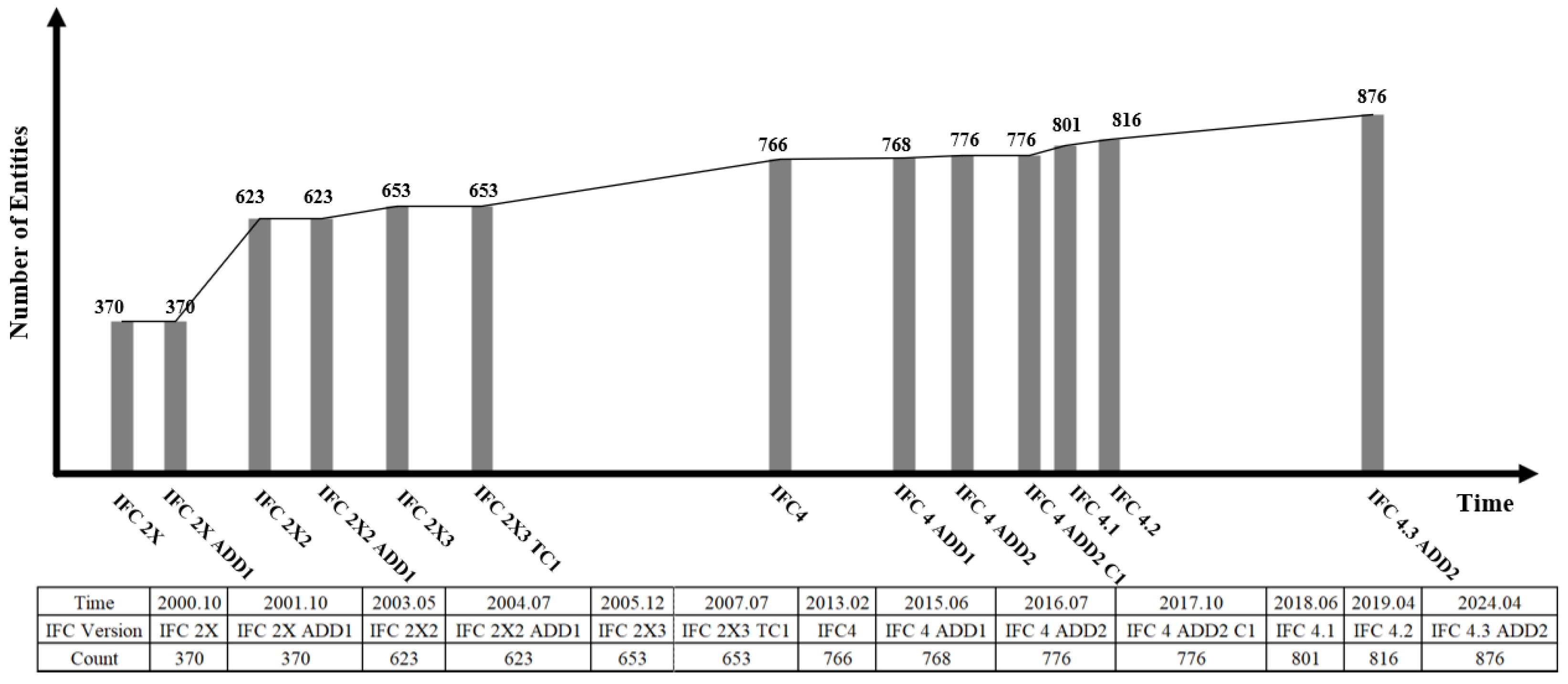
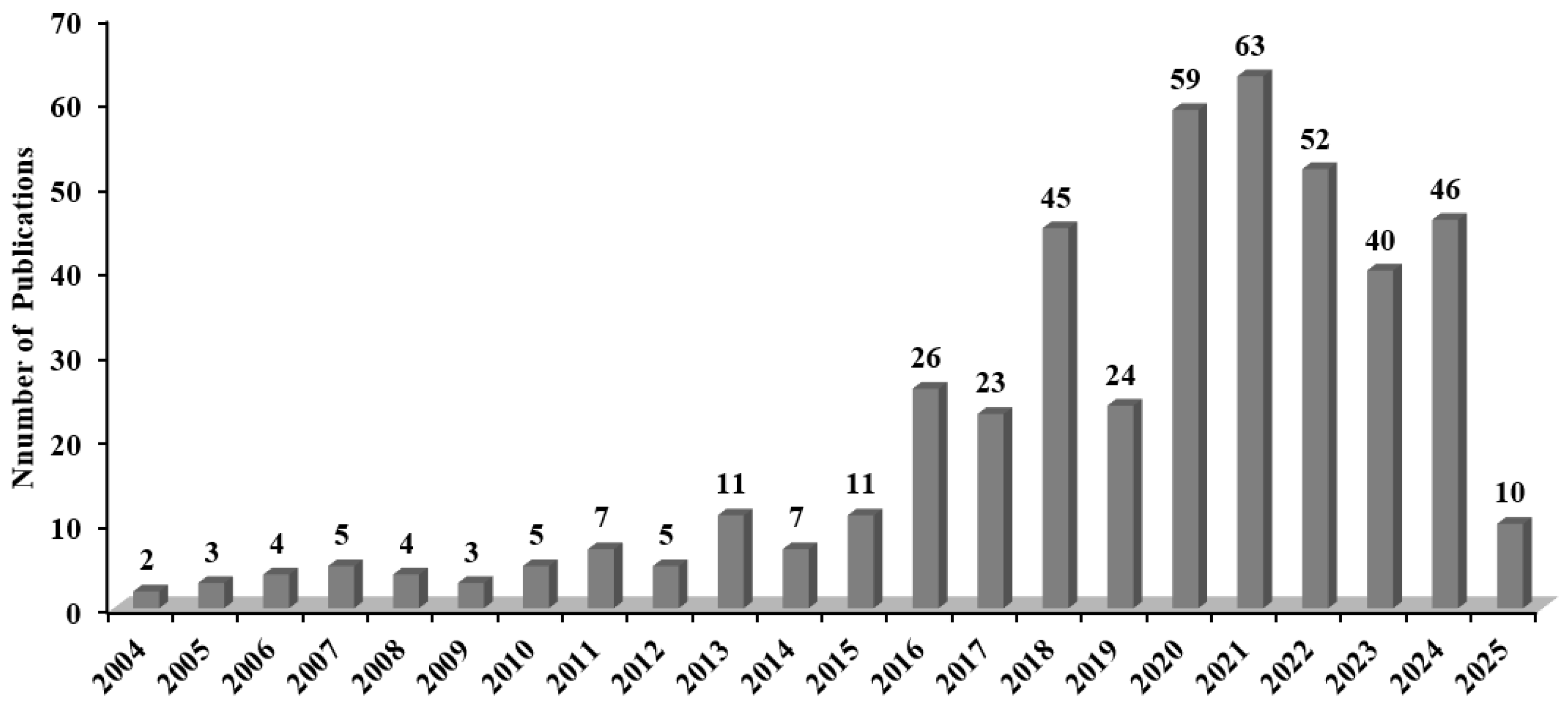
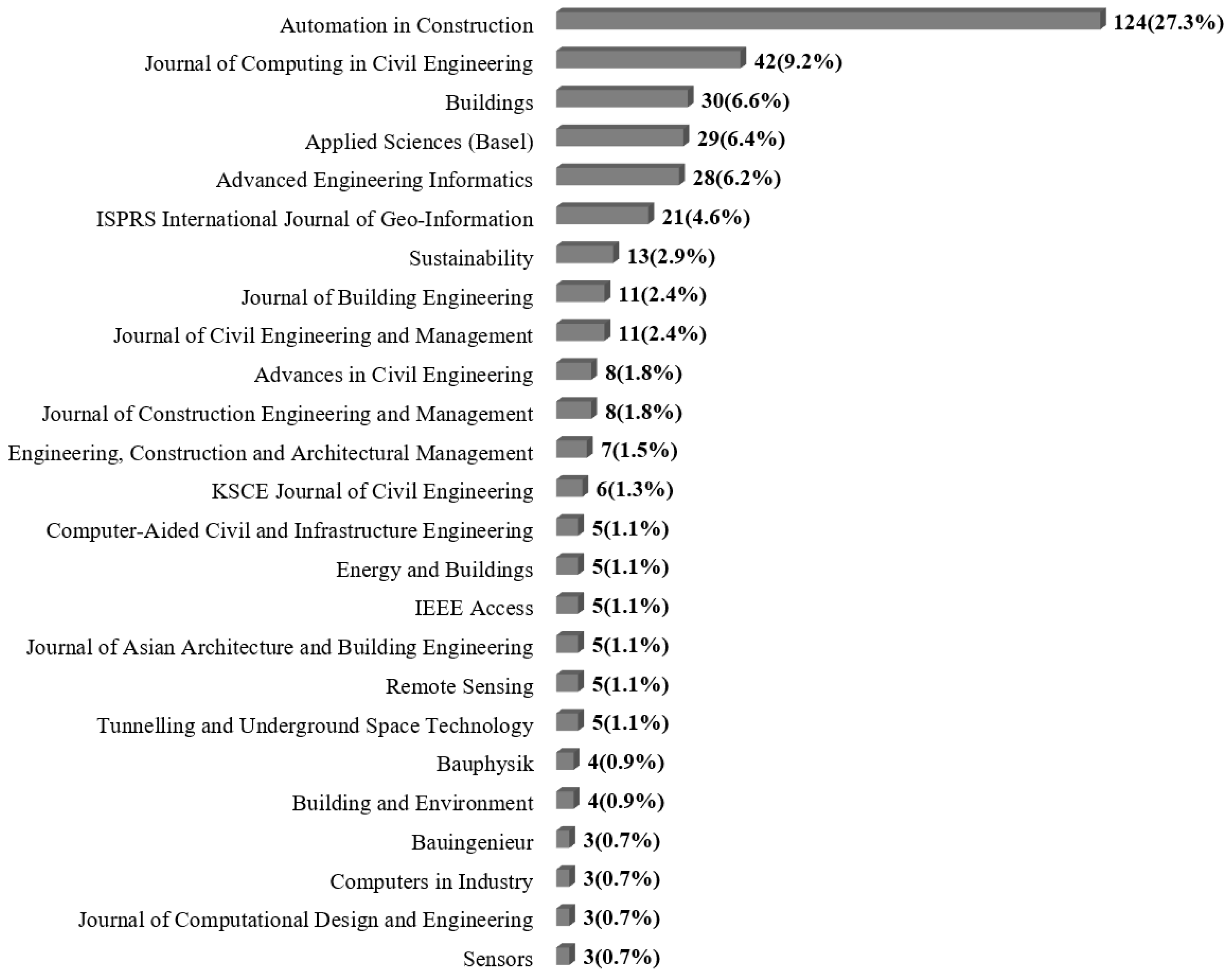
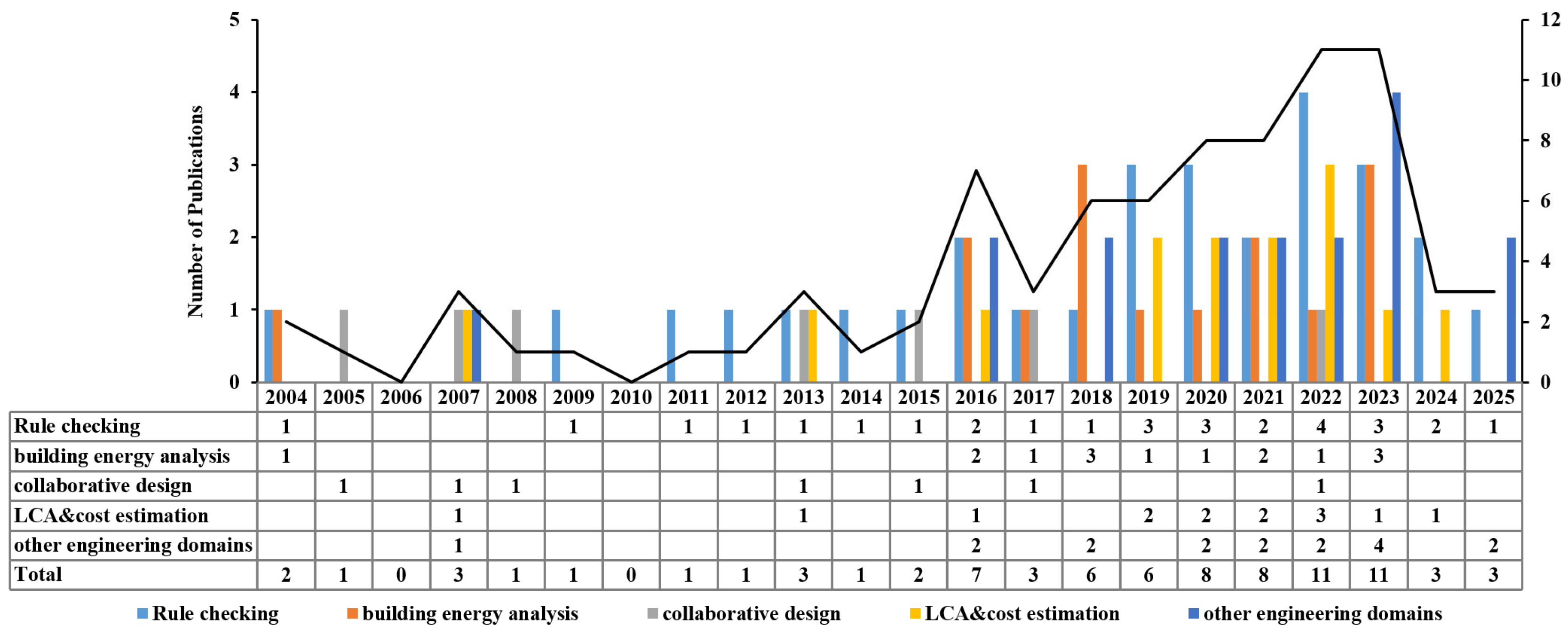
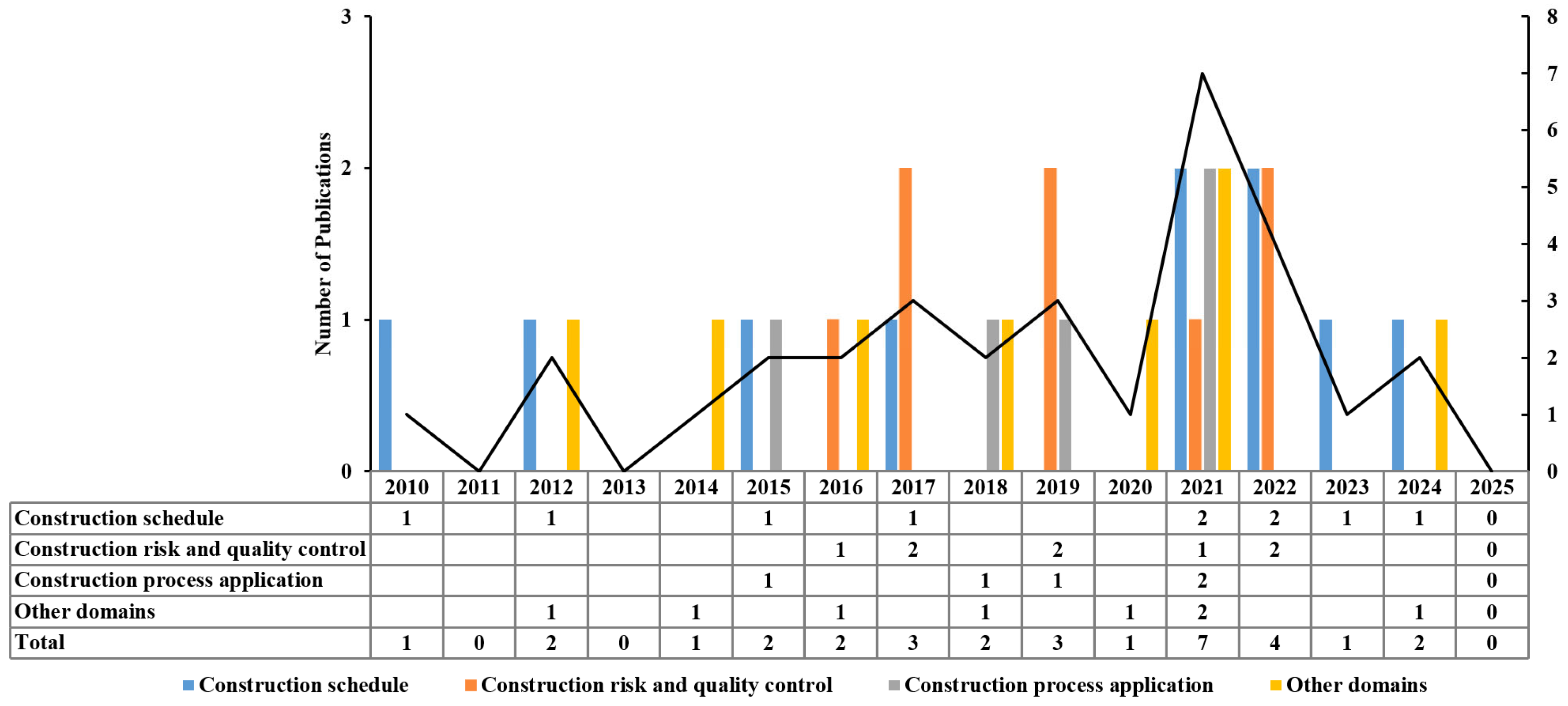
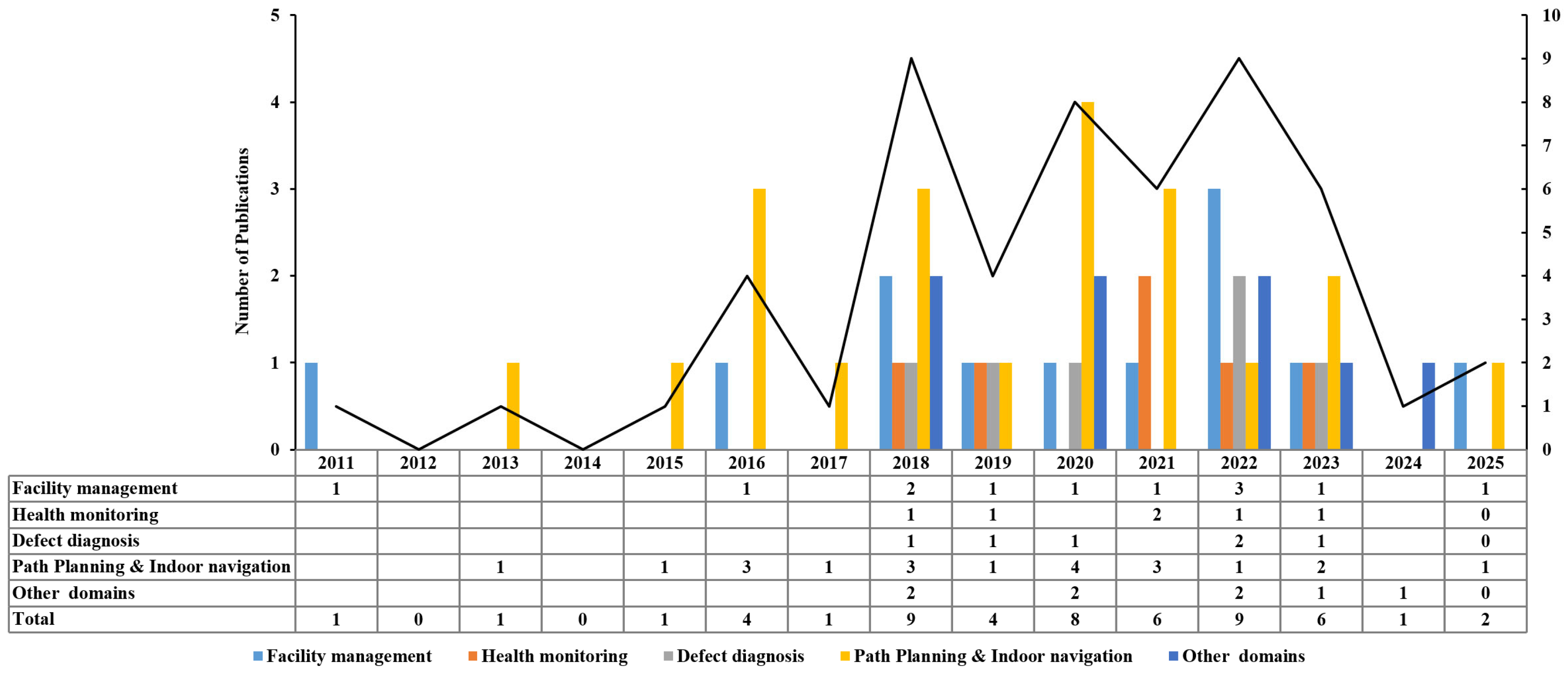
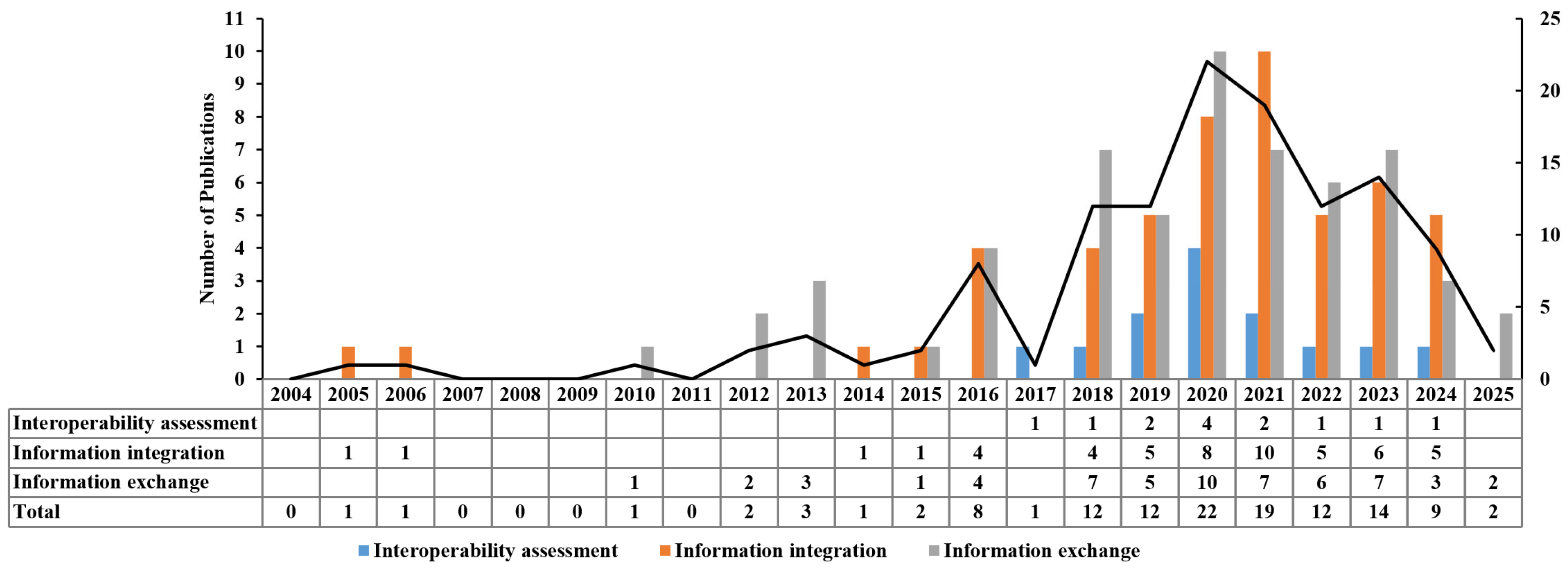
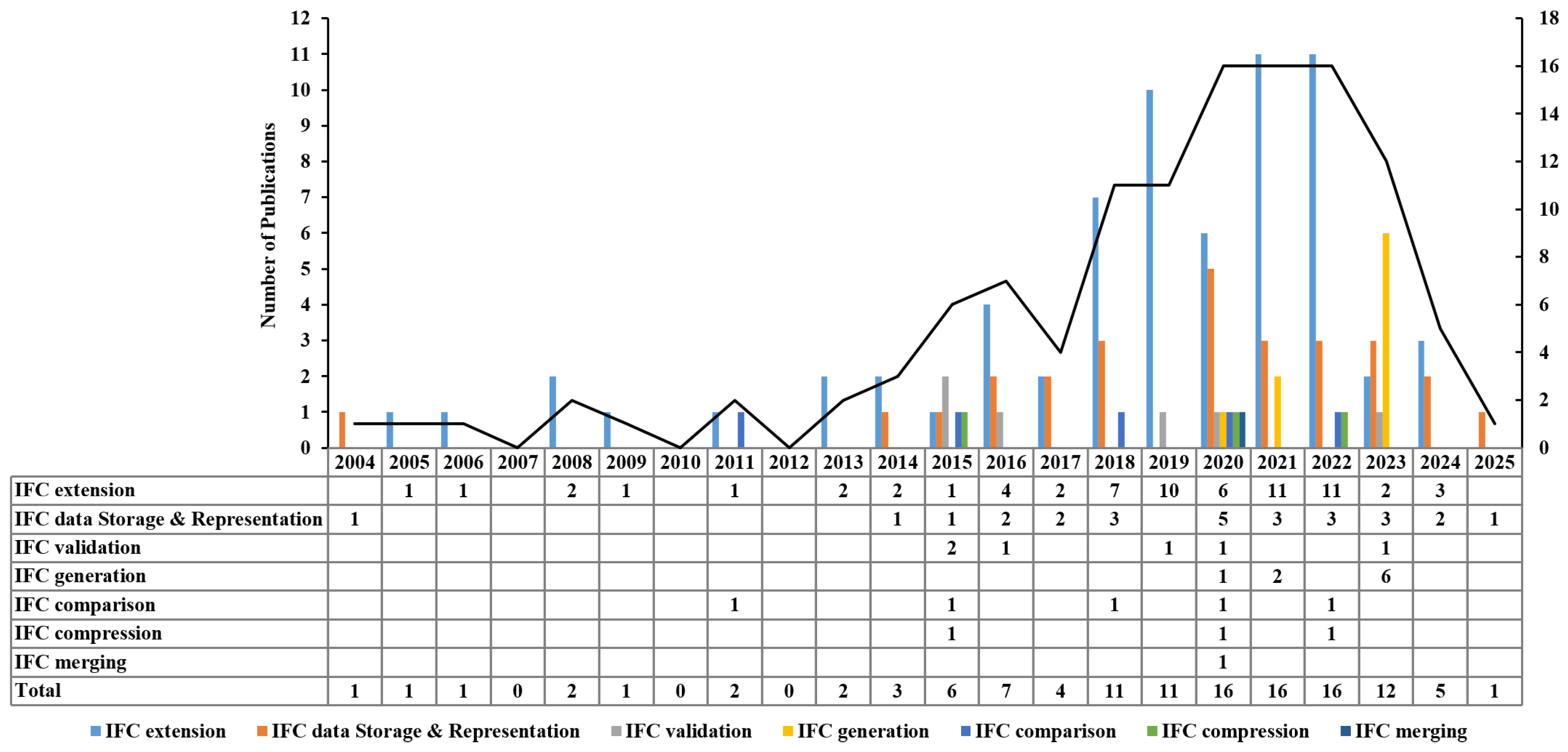

| Query Expression | Number of Publication |
|---|---|
| TS = IFC AND TS = Industry Foundation Classes | 433 |
| (KP = IFC OR KP = Industry Foundation Classes) AND ALL = Industry Foundation Classes | 19 |
| (TI = IFC OR TI = Industry Foundation Classes) AND ALL = Industry Foundation Classes | 157 |
| (AK = IFC OR AK = Industry Foundation Classes) AND ALL = Industry Foundation Classes | 322 |
| IFC Extraction Method | IFC-Based Solution | Ref. |
|---|---|---|
| No-Scheme IFC data extraction | All data instances referenced by IFC relationship entities are recursively extracted, together with the instances corresponding to the building elements selected by the user. | [94] |
| property-based IFC model extraction method | A property-based partial model view of IFC is defined, in which attributes specified in the partial model view definition are retrieved via IfcObject entities, while relationship attributes are accessed through relationship entities. | [95] |
| structural design information delivery method | The defined exchange requirements are mapped onto the IFC model, and an exchange model generation algorithm is developed to extract IFC data based on these requirements. | [96] |
| Selection Set-based IFC extraction method | The selection set is defined as a combination of IFC instances and rules and a general extraction language based on XML schema is proposed, which supports extraction requirements for object types, properties, and relationships. | [97] |
| instance-based IFC model extraction method | A hierarchical tree structure of IFC is constructed, and the tree nodes are iteratively traversed from the bottom up. Based on specific requirements, the physical IFC instances and attributes associated with IFC relationship entities are extracted during this process. | [98] |
Disclaimer/Publisher’s Note: The statements, opinions and data contained in all publications are solely those of the individual author(s) and contributor(s) and not of MDPI and/or the editor(s). MDPI and/or the editor(s) disclaim responsibility for any injury to people or property resulting from any ideas, methods, instructions or products referred to in the content. |
© 2025 by the authors. Licensee MDPI, Basel, Switzerland. This article is an open access article distributed under the terms and conditions of the Creative Commons Attribution (CC BY) license (https://creativecommons.org/licenses/by/4.0/).
Share and Cite
Li, Y.; Zhao, Q.; Yang, M.; Ma, Z.; Hei, X. Advancements and Applications of Industry Foundation Classes Standards in Engineering: A Comprehensive Review. Buildings 2025, 15, 2927. https://doi.org/10.3390/buildings15162927
Li Y, Zhao Q, Yang M, Ma Z, Hei X. Advancements and Applications of Industry Foundation Classes Standards in Engineering: A Comprehensive Review. Buildings. 2025; 15(16):2927. https://doi.org/10.3390/buildings15162927
Chicago/Turabian StyleLi, Yuchao, Qin Zhao, Mingsong Yang, Zhaoxi Ma, and Xinhong Hei. 2025. "Advancements and Applications of Industry Foundation Classes Standards in Engineering: A Comprehensive Review" Buildings 15, no. 16: 2927. https://doi.org/10.3390/buildings15162927
APA StyleLi, Y., Zhao, Q., Yang, M., Ma, Z., & Hei, X. (2025). Advancements and Applications of Industry Foundation Classes Standards in Engineering: A Comprehensive Review. Buildings, 15(16), 2927. https://doi.org/10.3390/buildings15162927






